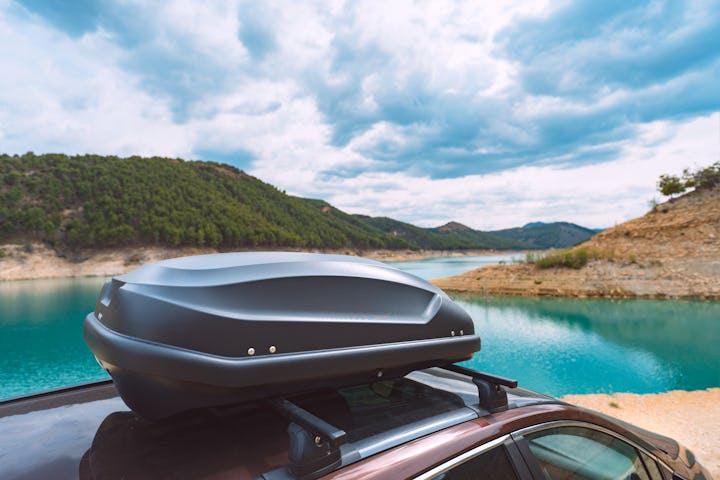Every Parent Needs A Rooftop Box
With these four expert tips, you won’t need a bigger car — and your fuel economy won’t suffer.

Rooftop boxes are a great solution for anyone who has a lot of cargo and not enough trunk space. They’re affordable, easy to install, and, so long as you follow a few key tips, efficient.
In case you’re only familiar with those hulking, old-school clamshell boxes, it’s important to note that modern rooftop boxes are lightweight, and, often, engineered to be both aerodynamic and opened from either the left or right side.
They’re also very easy to attach and detach from a vehicle’s crossbars, thanks to the mostly universal clamps on the boxes’ undersides. That, in turn, makes them a wise investment. If you find your car pinched for space only some of the time, just remove the box, leave it in the garage, and mount it as needed for the gear overflow.
The big question is how much gas mileage you’ll sacrifice with a rooftop box altering your vehicle’s aerodynamic profile. The answer? A bit, but a lot less than you’ll sacrifice if you get a bigger car. Even when a rooftop box is mounted on your car, rack- and box-maker Yakima’s internal data suggested that at most, you might lose 1 to 2 miles per gallon, which is a whole lot better than driving around a big SUV that’s 30% to 40% less fuel efficient at all times.
That said, both leading rack/box brands, Thule and Yakima, have some specific advice about where to put that box and how to position your car’s crossbars (if they’re moveable; some factory crossbars are fixed). Here, then, are some tips for buying, installing, and packing a rooftop box.
1. Measure Twice, Buy Once
When deciding what size and shape to go for, first, measure the length and width of your car’s roof. Then opt for a longer (rather than taller) box that’s more torpedo-shaped. Look up the actual capacity numbers of the box, too. The aim here is to purchase a box that’s wind-cheating and sleeker; that design is likely going to be longer than a really tall, squat model, but way better at slicing through the air.
Now hit the dealer, bring some of your junk with you, and load that test model with all your stuff. You want to be able to fit a folded stroller, maybe some luggage for a road trip, and everything else that seems to cram your car to near-bursting during longer trips. Make sure your box will fit everything you need (and then some).
2. Pack Smart
You should load a box according to the priority of what you’ll need to grab easily versus what you can stow away for the duration of the trip. Keep anything that you’ll need during your drive in the car for quick and easy access. Bigger, bulkier items, and anything you won’t need until you arrive, can go in the box overhead. Things like camping equipment, fold-up chairs for sporting events, and luggage are perfect for storing in your rooftop box. Is this workaround perfect? Nope. But it’s a lot easier than shelling out for a whole new ride.
Also, secure the items in your rooftop box as well as you can. This not only prevents the contents from sliding around, but it can also help you fit more gear in your box. Many rooftop boxes have internal loops for tie-downs, so be sure to take advantage of those.
3. Keep It Centered
Your rooftop rack should be centered along the crossbars as much as possible. This position, per Evan Hampton, category manager at Yakima, works with the airflow of how your car was already tested to cheat the wind. Thule also argues for centering the box.
Now, centering the box can make it a bit harder to actually reach your gear if your car is relatively tall. A decent hack for shorter folks: bring a step stool with you, and open the door of the car, too, which will allow you to get closer to the box.
4. Hang Back
Move the box back towards the rear of the vehicle. You don’t want the nose of the box hanging out over the windshield. That’s not only very un-aero, but it will mess with the handling of your car, causing lift at highway speeds. The latter is dangerous because it will mean you can’t steer as quickly in an emergency and could lead to hydroplaning in the rain. However, Yakima’s Hampton says you have two key considerations with sliding the box back.
- Where does the box actually mount to the crossbars and how far back can you go? Hampton says to use the wisdom of a professional (i.e., the dealer who sells the box, such as a retailer like REI or your local bike shop) to get this dialed correctly. Sliding the roof crossbar too far back may not meet your car manufacturer’s suggested positioning, which would negate your warranty if something goes awry.
- Can you still open the rear hatch? If you position your box too far towards the rear of the vehicle, it might get in the way of the hatch opening fully. So before you start tightening bolts, experiment with the box position with the hatch door open to make sure the coast is clear.
There’s no reason to upsize your vehicle if all you’re looking for is more space. With the right placement, a good rooftop box will get you everywhere you need to go with all the gear you could possibly need, and with minimal sacrifice to your auto’s fuel economy.